
realtests - <
a href="http://www.realtests.com/admission/ged-test.htm">http://www.realtests.com/admission/ged-test.htm
test-inside -
examsheets - http://www.examsheets.com/onlinetest/gre-test.htm
braindumps -
http://www.braindumps.com/testprep/lsat-practice-test.htm
braindumps -
http://www.selftestengine.com/studyguide/ccna-dumps.html
"Hobbits" - Homo floresiensis - is a new human species!
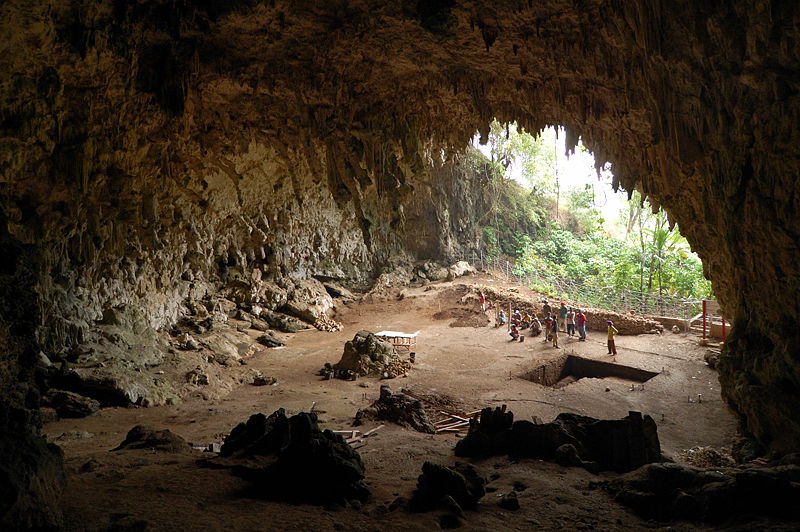
by Nancy Uon for viewzone.
[above: Liang Bua Cave on the island of Flores.] Back in 2003 a team of archaeologists were digging in a cave on the remote island of Flores, located in Indonesia. This region of the world is well known as the last unexplored place on Earth, second maybe to the deep Amazon jungle, and "lost civilizations" have been discovered as recently as the last decade. Sure enough, the team found the remains of human like skeletons that had never been seen before. Because they were unusually small yet fully grown, and appeared to resemble humans, they were affectionately called "Hobbits" -- reminiscent of the diminutive characters in J.R.R. Tolkein's novels.
Some anthropologists were quick to claim that a new species of humans had been found and named it homo floresiensis, while others claimed that these were the remains of "diseased" humans who had a condition known as "microcephaly," an abnormally small head. An example of this disease can be seen in Jennie Lee and Elvira Snow [right], also known as "The Snow Twins", who suffered from microcephaly. The disease is characterised by abnormally small craniums which gave rise at the time to the term "pinhead". Like most microcephaly sufferers Zip and Pip were mentally retarded, but although based at Coney Island, they also travelled with the World Circus Sideshow for many years. A total of seven different individuals were recovered in the Flores cave. The most complete skeleton was from a female and was given the nickname "Flo" and the scientific designation of LB1. Scientists were anxious to examine Flo and paid particular attention to her skull. 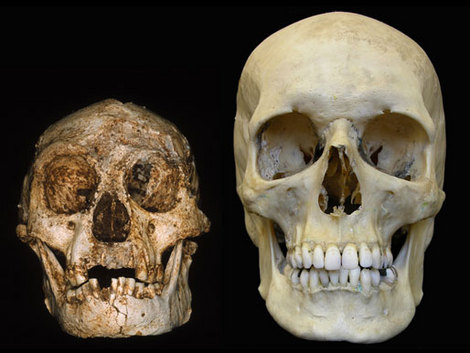 In January of 2009 the argument that Flo was a modern human suffering from microcephaly was put to rest. Dr. Karen Baab and Keiran McNulty of the University of Minnesota conducted a computerized scan of the skull, including the insides which contained the brain. They compared their precise measurements to a wide sample of other hominin fossils, humans and apes.
"A skull can provide researchers with a lot of important information about a fossil species, particularly regarding their evolutionary relationships to other fossil species. The overall shape of the LB1 skull, particularly the part that surrounds the brain (neurocranium) looks similar to fossils more than 1.5 million years older from Africa and Eurasia, rather than modern humans, even though Homo floresiensis is documented from 17,000 to 95,000 years ago." -- Dr. Baab One of the arguments used to support the "disease" theory was that the skull exhibited asymmetry -- one side of the skull was larger than the other. This frequently means the organism had some type of deformity or pathology. But after this extensive scan of Flo's skull it was determined that this slight asymmetry was not significant. In short, Dr. Baab discovered that Flo's skull was a scaled down hominid (ancient human) fossil and was definitely not a scaled down modern human's skull.
"The degree of asymmetry in LB1 was within the range of apes and was very similar to that seen in other fossil skulls. We suggest that the degree of asymmetry is within expectations for this population of hominins, particular given that the conditions of the cave in Indonesia in which the skull was preserved may have contributed to asymmetry." -- Dr. Baab But the skull remains an enigma. It seems out of place with the rest of the body. According to Dr. McNutty, the skull resembles a human that lived about a million years ago while the body resembles a human that lived three million years ago. And yet, according to scientific dating, these creatures lived just 17-thousand years ago and were contemporaries with modern humans!
"[Homo floresiensis] is the most exciting discovery in probably the last 50 years... We have shown with this study that the process of size reduction applied to fossil hominins accounts for many features seen in the fossil skull from Flores... It becomes much more difficult, therefore, to defend the hypothesis that the preserved skull is a modern human who simply suffered from an extremely rare disorder." -- McNutty The other bones examined After the world was primed to know about this interesting and possibly new species of humans, an international team of researchers led by the Smithsonian Institution completed a new study on Homo floresiensis. The team turned its research focus to the most complete of the 12 skeletons discovered and specifically toward three little bones from the hobbit's left wrist. The research asserts that modern humans and our closest fossil relatives, the Neandertals, have a very differently shaped wrist in comparison to living great apes, older fossil hominins like Australopithecus (e.g., "Lucy") and even the earliest members of the genus Homo (e.g., Homo habilis, the "handy-man").
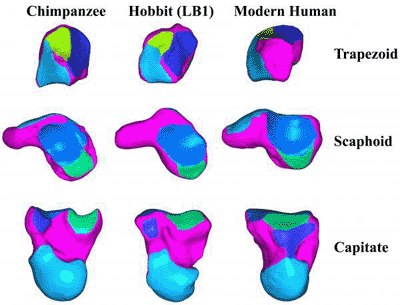 But the hobbit's wrist [above center] is basically indistinguishable from an African ape or early hominid-like wrist -- nothing at all like that seen in modern humans and Neandertals. According to Matt Tocheri, a paleoanthropologist who examined the wrist bones, "These hobbit wrist bones do not look anything like those of modern humans. They're not even close!" The evidence from the hobbit's wrist is extremely important because it demonstrates further that the hobbit indeed represents a different species of human as was originally proposed by its discoverers. It is not a modern human with some sort of pathology or growth disorder. The distinctive shapes of wrist bones form during the first trimester of pregnancy while most pathologies and growth disorders do not begin to affect the skeleton until well after that time. Therefore, pathologies or growth defects cannot adequately explain why a modern human would have a wrist that was indistinguishable from that of an African ape or primitive hominid. This evidence suggests that modern humans and Neandertals share an earlier human ancestor that the hobbits do not. Tocheri continued, "Basically, the wrist evidence tells us that modern humans and Neandertals share an evolutionary grandparent that the hobbits do not, but all three share an evolutionary great-grandparent. If you think of modern humans and Neandertals as being first cousins, then the hobbit is more like a second cousin to both." Examining the legs and feet The "Hobbit" feet were very unusual and so were all the limbs. Some questioned whether or not these small hominids could walk on such different feet. A new research paper, featured on the cover of the May 7, 2009 issue of Nature, may answer this question. 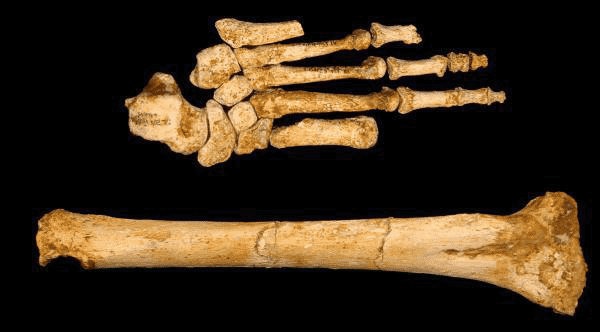 "The hobbits were bipedal, but they walked in a different way from modern humans," explains William Harcourt-Smith, a Research Scientist in the Division of Paleontology at the American Museum of Natural History and an author on the paper. "Their feet have a combination of human-like and more primitive early hominid traits, some of which are more akin to those in Lucy." (Lucy is an early bipedal but small-brained hominin, or australopithecine, that lived in Africa 3.2 million years ago). The anatomy of the foot described in the new paper might finally answer the pathological modern vs. primitive population question. Although the foot is characteristic of a biped—being stiff and having no opposable big toe (like modern day humans) -- many other traits fall outside of the range for modern humans. The H. floresiensis foot is very long in proportion to the lower limb and considerably more than half the length of the thighbone; modern human feet are relatively shorter at about half of the femur's length. The stubby big toe of the hobbit is another primitive, chimp-like trait. But the pivotal clue comes from the navicular bone, an important tarsal bone that helps form the arch in a modern human foot. The "hobbit" navicular bone is more akin to that found in great apes, which means that these hominids lacked an arch and were not efficient long-term runners. "Arches are the hallmark of a modern human foot," explains Harcourt-Smith. "This is another strong piece of the evidence that the "hobbit" was not like us." But is Homo floresiensis a new human species? According to William Junger, Chairman of the Department of Anatomical Sciences at Stony Brook University Medical Center,
"H. floresiensis is either an island-dwarfed descendant of H. erectus that not only underwent body-size reduction but also extensive evolutionary reversals, or, as our analysis suggests, it represents a new species full of primitive retentions from an ancestor that dispersed out of Africa much earlier than anyone would have predicted. Either way, the implications for human evolution are profound." The small brain problem The hobbits had extremely small brains. Estimates put it at about 400 ml. This is the smallest hominid brain ever recorded. How and why did the brain get so small?
Although the phenomenon of dwarfism on islands is well recognised in large mammals, an accompanying reduction in brain size has never been clearly demonstrated before. With the Madasgar hippos it has been theorized that the resuction in brain size evolved after the original hippos were somehow stranded and isolated from the African continent. It may be advantageous to the survival of animals that become isolated on islands with unique environments, not only to become dwarfs, but also to reduce the size of their brain. "The brain is a costly organ that uses a lot of energy," says Dr Weston. "Whatever the explanation for the tiny brain of floresiensis relative to its body size, it's likely that the fact that it lived on an island played a significant part in its evolution," concludes Dr Weston. With less food to supply energy, the smaller brain size became more efficient. Perhaps even the lack of environmental challenges of an island existence allowed for a reduction in brain function also.
"We found that the brain sizes of extinct dwarf hippos were still up to 30% smaller than you would expect by scaling down their mainland African ancestor to the dwarf’s body size. If the hippo model is applied to a typical H. erectus ancestor the resulting brain capacity is comparable to that of H. floresiensis." -- Dr. Eleanor Weston, Natural History Museum palaeontologist. The final word -- it's a NEW species! Researchers from Stony Brook University Medical Center in New York have confirmed that Homo floresiensis is a genuine ancient human species and not a descendant of healthy humans dwarfed by disease. 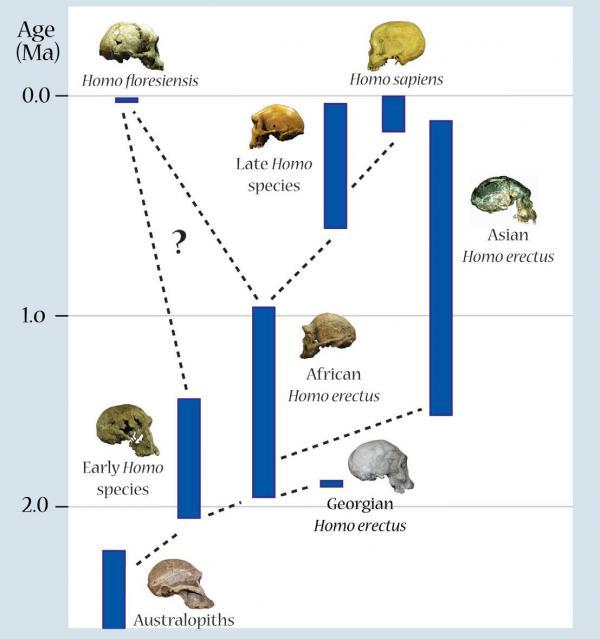 Using statistical analysis on skeletal remains of a well-preserved female specimen, researchers determined the "hobbit" to be a distinct species and not a genetically flawed version of modern humans. A summary of their work Researchers William Jungers, Ph.D., and Karen Baab, Ph.D. studied the skeletal remains of a female (LB1), nicknamed "Little Lady of Flores" or "Flo" to confirm the evolutionary path of the hobbit species. The specimen was remarkably complete and included skull, jaw, arms, legs, hands, and feet that provided researchers with integrated information from an individual fossil. The cranial capacity of LB1 was just over 400 cm, making it more similar to the brains of a chimpanzee or bipedal "ape-men" of East and South Africa. The skull and jawbone features are much more primitive looking than any normal modern human. Statistical analysis of skull shapes show modern humans cluster together in one group, microcephalic humans in another and the hobbit along with ancient hominins in a third. Due to the relative completeness of fossil remains for LB1, the scientists were able to reconstruct a reliable body design that was unlike any modern human. The thigh bone and shin bone of LB1 are much shorter than modern humans including Central African pygmies, South African KhoeSan (formerly known as 'bushmen") and "negrito" pygmies from the Andaman Islands and the Philippines. Some researchers speculate this could represent an evolutionary reversal correlated with "island dwarfing."
"It is difficult to believe an evolutionary change would lead to less economical movement. It makes little sense that this species re-evolved shorter thighs and legs because long hind limbs improve bipedal walking. We suspect that these are primitive retentions instead." -- Dr. Junger Further analysis of the remains using a regression equation developed by Dr. Jungers indicates that LB1 was approximately 106 cm tall (3 feet, 6 inches) -- far smaller than the modern pygmies whose adults grow to less than 150 cm (4 feet, 11 inches). A scatterplot depicts LB1 far outside the range of Southeast Asian and African pygmies in both absolute height and body mass indices. "Attempts to dismiss the hobbits as pathological people have failed repeatedly because the medical diagnoses of dwarfing syndromes and microcephaly bear no resemblance to the unique anatomy of Homo floresiensis," noted Dr. Baab. More News: Hobbit ancestors once colonized Indonesia island Posted 2010/03/17 HONG KONG, Mar. 17, 2010 (Reuters) -- Ancestors of a hobbit-like species of humans may have colonized the Indonesian island of Flores as far back as a million years ago, much earlier than thought, according to a new study published Thursday. These early ancestors, or hominins, were previously thought to have arrived on the island about 800,000 years ago but artifacts found in a new archaeological site suggest they might have been around even earlier. In a paper published in Nature, researchers said their findings suggest these hominins may have evolved into tiny hobbit-like humans, or "Flores man," who stood about a meter tall and had skulls the size of grapefruit. Skeletal remains of an 18,000-year-old "Flores man" were discovered about five years ago and scientists then determined it belonged to a species of human completely new to science. Named Homo floresiensis, after the island on which it was found, the tiny human has also been dubbed "hobbit," after the tiny creatures from the "Lord of the Rings." The arrival of hominins is also believed to have resulted quickly in the mass death of giant tortoises and the Stegondon sondaari, a pygmy elephant, on the island. In their paper, the researchers said they found 45 stone tools in Wolo Sege in the Soa basin in Flores. Led by Adam Brumm at the Center of Archaeological Science in the University of Wollongong in New South Wales, Australia, the researchers used new dating methods and found that the stone tools were about a million years old. "It is now clear, however, in light of the evidence from Wolo Sege, that hominins were present on Flores (a million years ago). This suggests that the non-selective, mass death of Stegondon sondaari and giant tortoise ... could represent a localized or regional extinction," they wrote in their paper. "Flores man" is thought to be a descendant of homo erectus, who had a large brain, was full-sized and spread out from Africa to Asia about two million years ago. Scientists suspect "Flores man" lived at the same time as modern humans and became extinct after a massive volcanic eruption on the island around 12,000 years ago.
|
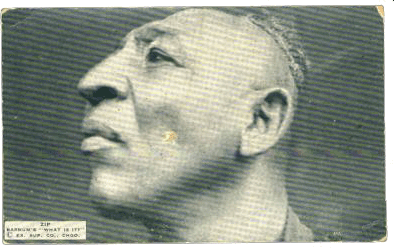 When the bones and fragments were collected, they revealed that the human-like creatures lived on the island from about 95,000 to 17,000 years ago. They were about 3 foot, 11 inches tall, yet their head was disproportionately small -- about 30% smaller than if a human body was scaled down to their size.
When the bones and fragments were collected, they revealed that the human-like creatures lived on the island from about 95,000 to 17,000 years ago. They were about 3 foot, 11 inches tall, yet their head was disproportionately small -- about 30% smaller than if a human body was scaled down to their size.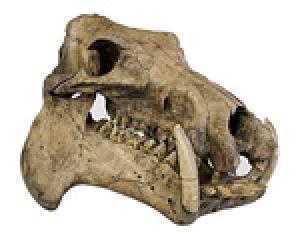 Scientists from the Natural History Museum attempt to answer this question by examining something called the "Island Dwarfism" phenomenon. They use the skull of the extinct Madagascar pygmy hippos as their example. These animals were found to have a brain size that was 30% smaller than normal for their reduced proportions -- about the same anomaly that was seen in Homo floresiensis.
Scientists from the Natural History Museum attempt to answer this question by examining something called the "Island Dwarfism" phenomenon. They use the skull of the extinct Madagascar pygmy hippos as their example. These animals were found to have a brain size that was 30% smaller than normal for their reduced proportions -- about the same anomaly that was seen in Homo floresiensis.